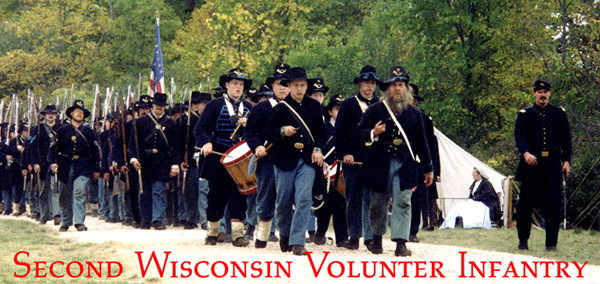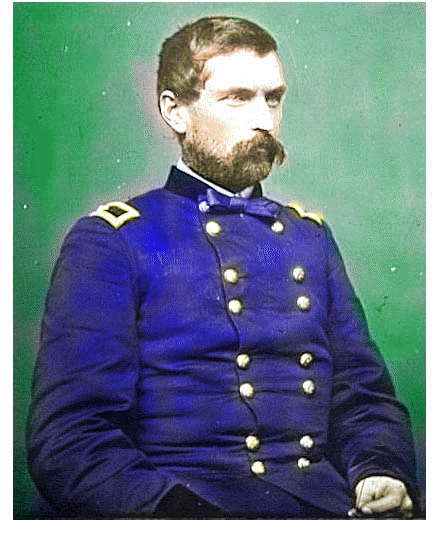
Brief History of the Second Wisconsin:

![]() Eastern
Theatre Engagements of the Second Wisconsin
Eastern
Theatre Engagements of the Second Wisconsin
THE SECOND WISCONSIN VOLUNTEER REGIMENT AND
BATTERY B, 4TH U.S. ARTILLERY
The regiment was organized at Madison, Wis. on 11 June
1861 as a three year regiment.
They were issued Harper's Ferry muskets (converted flintlock) with 40 rounds of Buck &
Ball ammunition. It was the first three year regiment arrive in Washington for the defense
of the National Capitol after Lincoln issued his call for more troops to defend it. They
arrived June 25 and marched through the streets 1000 strong. Three years later few were
left. Their first engagement was Blackburn's Ford and First Bull Run under W T Sherman.
The State had supplied them with gray uniforms, therefore they were fired upon by both
sides. Despite this and their lack of experience,. they gave a good accounting of
themselves against Stonewall Jackson's troops and held their ground until
General Joseph E. Johnston, and his last contingent of reinforcements arrived
from the Valley beating them back. In the retreat which soon turned into a rout for most Union Troops the
Second withdrew in good order and fought rear guard action. In May 1862 the 2nd Regiment
together with the 6th and 7th Wisconsin and 19th Indiana were placed under the command of
Gen. John Gibbon.
He issued an order to standardize the uniform adding white gloves and gaiters to the dark blue frock coat, blue trousers, and requiring all to have a black felt hat, the most distinctive part of the uniform, the Hardee, or Jeff Davis, hat which was worn with the left brim turned up and a black plume on the right side. From this hat the brigade acquired the name "The Black Hat Brigade'.
At Fredericksburg, in order to have the regiments of the brigade in the same uniform, I had ordered all to be equipped with the regulation black felt hats. In the battle of Gainesville, the men we took prisoners asked who "'Those black hatted fellows were" they had been fighting and after that the men were accustomed to refer to themselves as "The Black Hat Brigade." How or where the name of the "Iron Brigade" was first given I do not know but soon after the battle of Antietam the name was started and ever after was applied to the brigade.
John Gibbons
During the Battle of South Mountain, Md., Gibbon's men gave such a good account of themselves that Corps Commander Hooker referred to them as an 'Iron Brigade.
The name stuck with them for the rest of the war and forever after they retained the title
On one occasion Gen. McClellan said, "I have seen them under fire acting in such a manner as to reflect the greatest credit upon themselves and their State (Wis.). They are equal to the best soldiers in the world. It is not the numbers of men but the right kind of men that makes the 'IRON BRIGADE.' The BRIGADE was later joined by the 24th Michigan to help replace heavy losses sustained in battle.

Gen. John Gibbon
Gibbon's historic Battery B' of the 4th US. Artillery was
assigned to the Brigade for artillery support. The Battery had been organized in March 1821 and had participated in the
Florida War of 1837, at Odgensburg in 1842 and 1843 when there was Canadian frontier
trouble. In 1845 it was in General Taylor's Army of Observation's the Rio Grande and in
the Mexican War provided distinguished service at Buena Vista, To fill out its ranks,
volunteers
from the volunteer regiments in the Brigade were selected, and attached to the Battery,
many from the Second Wisconsin.


| Second Wisconsin Volley, Antietam |
They were at Bull Run, Gainesville, Second Bull Run, South Mountain and Antietam and Gettysburg and Orange Court House, Beaver Dam Station, Rappahannock Station, Sulfur Springs Fredricksburg, Fizhugh's Crossing, Chancellorsville, Brandy Station, Wilderness, Laurel Hill, Spotsylvania, North Anna, Jericho Ford, Bethesda Church, and Cold Harbor.
The Second Wisconsin fought in most of the major battles in the Virginia, Maryland and Pennsylvania area. It may be there is no prouder record of service in the Union Army that that of the Second Wisconsin Volunteer Infantry Regiment. No other regiment in the entire Union Army was as active and sustained as great a percentage of killed in the saving of the Union.
Fox's
Regimental Losses In The American Civil War 1861-1865
By William F. Fox, Lt. Col., U.S. V.
President Of The Society Of The Twelfth Army Corps; Late
President Of The 10th N.Y. Veteran
Volunteers' Association; And Member Of The New York
Historical Society.
Albany, N.Y.
Albany Publishing Company
1889
KILLED AND DIED OF WOUNDS.
| Regiment. | Division.(*) | Corps. | Enrolled. | Killed. | Percent |
| 2d Wisconsin | Wadsworth's | First | 1203 | 238 | 19.7 |
| 1st Maine H. Art'y | Birney's | Second | 2202 | 423 | 19.2 |
| 57th Massachusetts | Stevenson's | Ninth | 1052 | 201 | 19.1 |
| 140th Pennsylvania | Barlow's | Second | 1132 | 198 | 17.4 |
| 26th Wisconsin | Schurz's | Eleventh | 1089 | 188 | 17.2 |
| 7th Wisconsin | Wadsworth's | First | 1630 | 281 | 17.2 |
| 69th New York | Hancock's | Second | 1513 | 259 | 17.1 |
| 11th Penn. Reserves | Crawford's | Fifth | 1179 | 196 | 16.6 |
| 142d Pennsylvania | Doubleday's | First | 935 | 155 | 16.5 |
| 141st Pennsylvania | Birney's | Third | 1037 | 167 | 16.1 |
| 19th Indiana | Wadsworth's | First | 1246 | 199 | 15.9 |
| 121st New York | Wright's | Sixth | 1426 | 226 | 15.8 |
| 7th Michigan | Gibbon's | Second | 1315 | 208 | 15.8 |
| 148th Pennsylvania | Barlow's | Second | 1339 | 210 | 15.6 |
| 83d Pennsylvania | Griffin's | Fifth | 1808 | 282 | 15.5 |
| 22d Massachusetts | Griffin's | Fifth | 1393 | 216 | 15.5 |
| 36th Wisconsin | Gibbon's | Second | 1014 | 157 | 15.4 |
| 27th Indiana | Williams's | Twelfth | 1101 | 169 | 15.3 |
| 5th Kentucky | T.J. Wood's | Fourth | 1020 | 157 | 15.3 |
| 27th Michigan | Willcox's | Ninth | 1485 | 225 | 15.1 |
| 79th U.S. Colored | Thayer's | Seventh | 1249 | 188 | 15 |
| 17th Maine | Birney's | Third | 1371 | 207 | 15 |
| 1st Minnesota | Gibbon's | Second | 1242 | 187 | 15 |